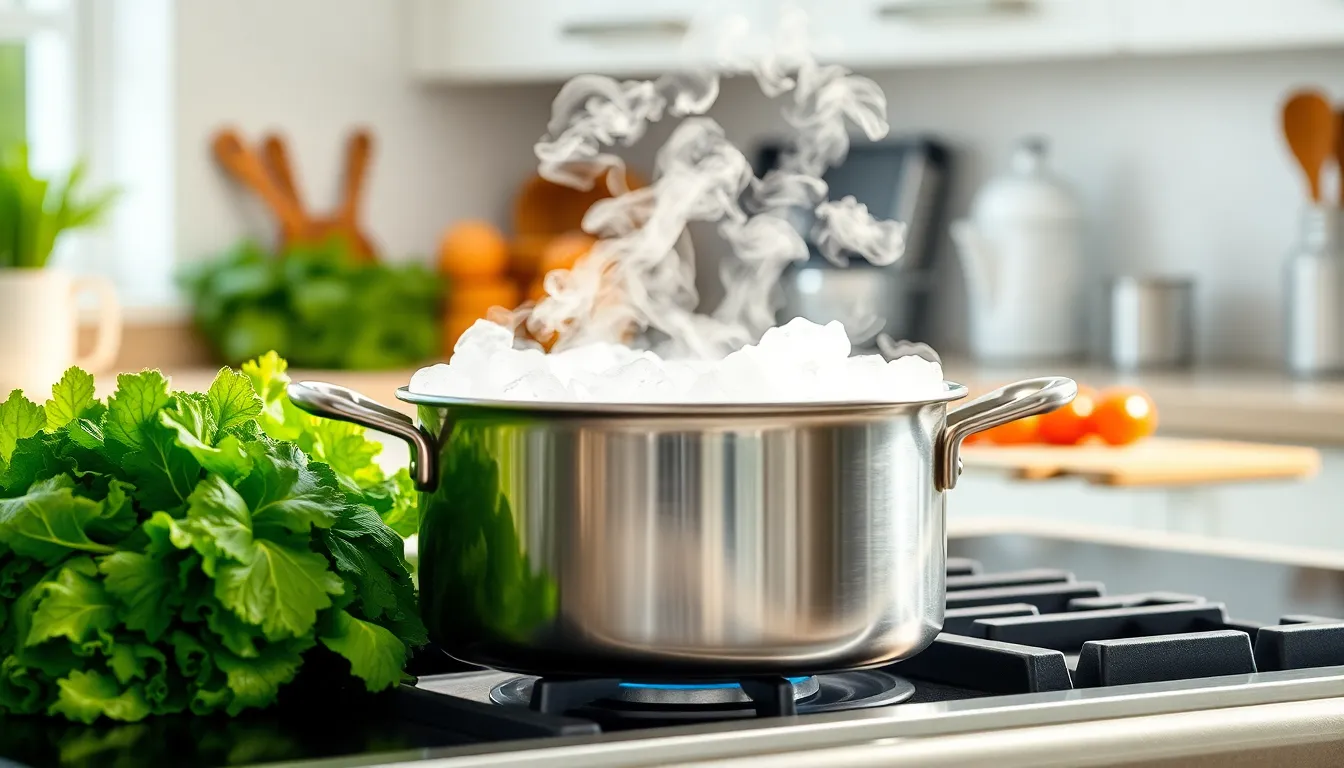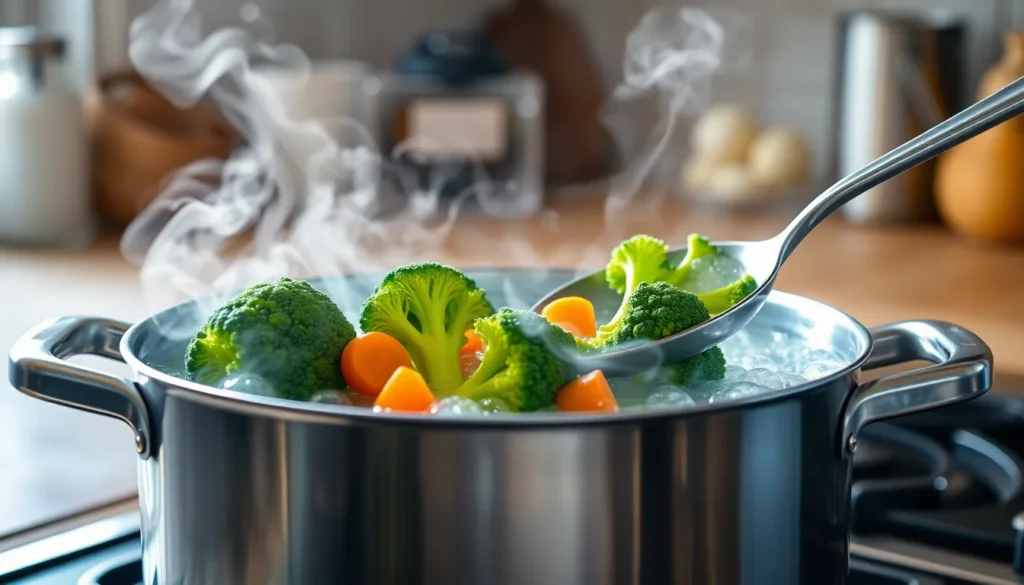Boiling: it’s not just a method of cooking; it’s a culinary rite of passage. Picture this: you’re standing in the kitchen, staring at a pot of water, contemplating your life choices while waiting for those tiny bubbles to make their grand entrance. It’s the moment when water transforms from a calm lake to a bubbling cauldron, ready to turn your ingredients into something magical.
Table of Contents
ToggleBoiling Definition Cooking
Boiling represents a primary method of cooking that involves heating water or a liquid until it reaches its boiling point, typically 212°F (100°C) at sea level. This technique triggers rapid bubble formation, allowing ingredients to cook evenly and thoroughly.
Vegetables, pasta, and eggs benefit greatly from boiling. Each ingredient requires specific cooking times to achieve optimal texture and flavor. When boiling vegetables, for instance, an individual should aim for vibrant colors and tender-crisp consistency, which typically takes three to five minutes depending on the type.
Different liquids can influence the outcome. Using salted water for boiling pasta enhances flavor absorption. In contrast, boiling eggs in water with vinegar promotes easier peeling post-cooking.
The process of boiling also facilitates the extraction of flavors. Cooking meats or legumes in broth rather than plain water adds depth. As ingredients boil, they release their essence, creating a foundation for soups and sauces.
Monitoring the boiling process is essential for achieving the desired result. A rolling boil signifies that the liquid is at the correct temperature. Adjusting the heat levels can prevent ingredients from overcooking or losing nutrients.
Boiling serves as a versatile cooking method. It not only cooks food quickly but also allows for easy preparation of large quantities. When managed properly, boiling maximizes both taste and texture in a wide range of dishes, making it a fundamental technique in any kitchen.
The Science Behind Boiling

Boiling involves intricate physical processes. It relies on heat transfer, vaporization, and the behavior of water or liquids at high temperatures.
Heat Transfer in Boiling
Heat transfer occurs through conduction, convection, and radiation. Conduction enables direct heat transfer from the stove to the pot. Convection circulates hot liquid around the ingredients, promoting even cooking. Radiation also contributes when heat radiates from the stovetop. As water reaches its boiling point, bubbles form and rise to the surface, releasing steam into the air. This vaporization effectively cooks food by ensuring uniform temperature distribution. Ingredients like pasta or vegetables undergo rapid temperature adjustments, resulting in optimal texture and flavor. In boiling, precise temperature control ensures effective heat transfer, maximizing culinary outcomes.
Types of Boiling
Several boiling methods exist to achieve different culinary results. Rolling boil signifies vigorous bubbling, ideal for cooking pasta rapidly. Simmering involves gentler bubbling, allowing for tender cooking of delicate ingredients. Blanching requires brief boiling to retain color and texture before immersion in ice water. Parboiling partially cooks food, providing a head start before final cooking methods. Steam boiling combines both boiling and steaming, where water produces steam that envelops food. Understanding these types enhances culinary skills, allowing chefs to select the method best suited for each dish. Each boiling style plays a crucial role in culinary applications, enhancing flavor and texture.
Techniques for Boiling
Boiling techniques vary depending on the desired outcome and specific ingredients being used. Mastering these methods ensures optimal results in various dishes.
Equipment Needed
A few essential kitchen tools support the boiling process. A large pot or saucepan accommodates plenty of water for boiling food items. A heat source, such as a stove or burner, provides the necessary heat to achieve boiling temperatures. A thermometer helps monitor water temperature when precision is required. Strainers or colanders assist in draining food after boiling. Lastly, a lid for the pot retains heat and speeds up boiling efficiency.
Common Foods to Boil
Many foods lend themselves well to boiling. Vegetables such as carrots, potatoes, and green beans cook quickly and develop vibrant flavors when boiled. Pasta benefits from boiling, requiring careful timing to achieve the perfect texture. Eggs, boiled for varying durations, yield different results, from soft to hard-boiled. Additionally, legumes like beans and lentils absorb water and soften when boiled, making them ideal for soups and stews. These foods benefit significantly from boiling, enhancing their taste and texture effectively.
Benefits of Boiling in Cooking
Boiling offers numerous advantages in cooking, enhancing both flavor and texture. First, the technique allows for even cooking, ensuring that ingredients receive consistent heat. Rapid cooking achieved through boiling retains the natural colors of vegetables, making dishes visually appealing.
Flavor extraction occurs effectively during boiling, particularly when utilizing broth, enhancing the taste of meats and legumes. Nutrient preservation is another benefit, as boiling can lock in vitamins while softening ingredients. For example, blanching vegetables before freezing retains their freshness, preventing nutrient loss.
Texture improvement is significant; boiling softens tough ingredients, making them more palatable. Cooking pasta in boiling salted water ensures optimal firmness, which prevents undesired stickiness. Additionally, boiling enables easier peeling of eggs, saving time during meal preparations.
Boiling aids in food safety by cooking ingredients thoroughly, reducing the risk of foodborne illnesses. Specific foods, like potatoes and carrots, develop better flavors when boiled, further demonstrating its effectiveness.
Tracking boiling times prevents overcooking, which may lead to nutrient degradation. Using a thermometer or visual cues, cooks maintain control over the process, maximizing culinary results. Moreover, incorporating infused herbs and spices during boiling enhances flavor profiles, allowing for creativity in dishes.
Boiling remains an essential technique in culinary practices, serving versatile purposes across various cuisines. Overall, the benefits of boiling extend beyond mere cooking, influencing texture, flavor, and nutritional integrity.
Boiling stands out as a fundamental cooking technique that transforms ingredients while enhancing their flavors and textures. By mastering the art of boiling, cooks can unlock a world of culinary possibilities. The careful balance of temperature and time ensures that each ingredient reaches its optimal state, whether it’s a vibrant vegetable or a hearty legume.
With the right tools and techniques, boiling becomes more than just a method; it’s a pathway to delicious meals. By understanding the science behind boiling and experimenting with different liquids and seasonings, anyone can elevate their cooking game. Embracing this versatile technique not only improves dishes but also fosters a deeper appreciation for the culinary arts.





